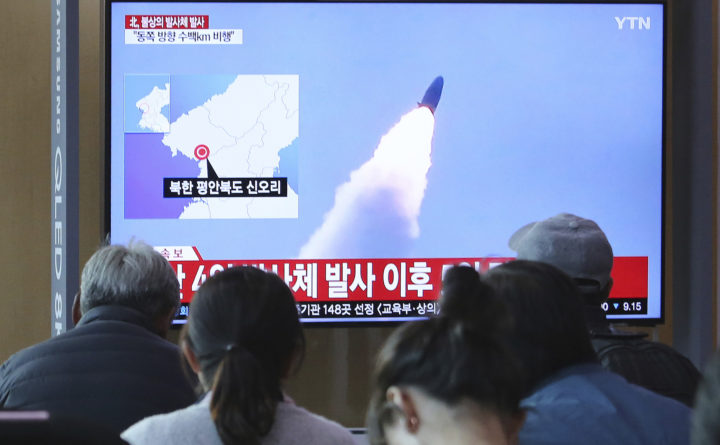
SEOUL, South Korea — North Korea fired two suspected short-range missiles on Thursday, South Korea’s military said, its second weapons launch in five days and a possible warning that nuclear disarmament talks with Washington could be in danger.
South Korea’s Joint Chiefs of Staff said the weapons flew 260 miles and 167 miles, respectively. It said it is working with the United States to determine more details, such as the type of weapon that was fired.
Kusong is also home to missile test facilities that were critical to the development of North Korea’s solid-fuel Pukguksong-2, which was successfully flight-tested for the first time in February 2017, in the North’s first missile test after President Donald Trump took office.
The launch came as U.S. Special Representative for North Korea Stephen Biegun is visiting South Korea, and hours after the North described its firing of rocket artillery and an apparent short-range ballistic missile on Saturday as a regular and defensive military exercise. North Korea also ridiculed South Korea for criticizing those launches.
There was no immediate comment from the United States.
Some analysts have said that if North Korea resumes testing the kind of longer-range banned ballistic weapons that it fired in unusually large numbers in 2017 — when many feared a U.S.-North Korea standoff could end in war — it may signal that North Korea is turning away from diplomacy.
A summit earlier this year between Trump and Kim ended in failure, with the United States saying that North Korea was not offering to take enough disarmament steps in return for the widespread sanctions relief it sought.
Just ahead of the Thursday launch, senior defense officials from South Korea, the United States and Japan met in Seoul to discuss North Korea’s earlier launches on Saturday and other security issues. Details from the meeting weren’t immediately announced.
With the consecutive weapons launches, North Korea is pressuring South Korea to turn away from the United States and support North Korea’s position more strongly, said Du Hyeogn Cha, a visiting scholar at Seoul’s Asan Institute for Policy Studies. Following the collapse of the Trump-Kim meeting, North Korea demanded that South Korea proceed with joint economic projects that have been held back by U.S.-led sanctions against the North.
By firing weapons that directly threaten South Korea but not the U.S. mainland or its Pacific territories, North Korea also appears to be testing how far Washington will tolerate its bellicosity without actually causing the nuclear negotiations to collapse, Cha said.
South Korean and U.S. officials have described what North Korea fired Saturday as “projectiles,” a broader term that includes both missiles and artillery pieces. This could be an effort to keep diplomacy alive as U.N. sanctions bar North Korea from engaging in any ballistic activity.
Some observers say North Korea may fire more missiles, including medium-range ones, to increase the pressure on the United States. Cha said North Korea isn’t likely to fire longer-range missiles, such as its Hwasong-12 intermediate-range missiles and Hwasong-14 and -15 intercontinental ballistic missiles, unless it intends to completely abandon diplomacy since it is certain to invite new U.N. sanctions.
Kim in a New Year’s speech said he hopes to continue his nuclear summitry with Trump, but would seek a “new way” if the United States persists with sanctions and pressure against North Korea.
Following the collapse of his second summit with Trump in February, Kim said he is open to a third meeting, but set the end of the year as a deadline for Washington to offer mutually acceptable terms for an agreement.
This article originally appeared on www.bangordailynews.com.







